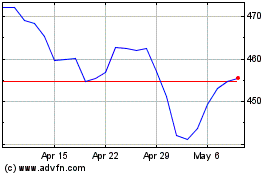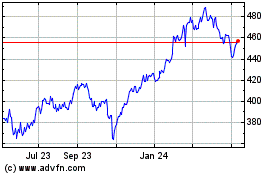By Robin Sidel
The ATM is the newest front in the war against cyberthieves.
A year after millions of U.S. merchants began installing
equipment at the check-out line to accept credit and debit cards
with security chips, the automated teller machine is getting
similar technology.
The move comes as thieves increasingly target ATMs. While
chip-enabled credit cards are expected to slow growth in fraud at
the checkout counter, the number of ATMs compromised by criminals
jumped more than sixfold from 2014, according to a recent report
from FICO, a credit-score provider and analytics firm. FICO says
the number of 2015 compromises was the highest it ever recorded,
though it declined to disclose specific numbers.
The burst of ATM-related fraud also was the largest one-year
increase since FICO started keeping track of such data about a
dozen years ago. Meanwhile, rates of credit-card fraud, a more
popular scheme for criminals, have largely leveled off.
The push to make ATMs more secure takes on added significance
this month: Under MasterCard Inc.'s network rules, ATM operators on
Oct. 21 will become liable for any fraud costs that occur if a
MasterCard chip-enabled card is used at a machine that isn't
equipped with chip technology. That cost is currently borne by the
card-issuing bank. Visa makes a similar shift next October.
The shift to more secure ATMs is expected to tackle the growing
problem known as skimming, by which criminals rig a machine with a
surreptitious device that can steal a customer's card data, often
including the personal identification number. The crook can then
use the data to make a counterfeit card and drain the associated
bank account.
The computer chip embedded in many new U.S. credit and debit
cards fights such fraud by creating a one-time code for each
transaction, limiting the ability of a thief to steal and replicate
data.
"The U.S. market is definitely being targeted with card
skimming," says Owen Wild, global marketing director for enterprise
fraud and security at NCR Corp., one of the largest makers of ATMs.
Nonbank ATMs account for 60% of recent incidents, up from 39% in
2014, the FICO analysis found.
Cyberthieves make at least 1.5 million illicit ATM cash
withdrawals in the U.S. each year, according to consulting firm
Tremont Capital Group. That figure represents a tiny fraction of
the 5.8 billion ATM withdrawals consumers made in 2013, according
to a Federal Reserve estimate.
Still, theft from ATM skimming can be more dangerous to
consumers than credit-card fraud because the debit card is tied
directly to a consumer's checking account. Banks will typically
reimburse customers for losses, but the process can be
complicated
Cost is an issue for ATM operators; It typically costs between
$300 and $700 to upgrade an existing ATM to accept chip cards, says
Brad Daniel, president at America's ATM, a Plantation, Fla.,
company that maintains a fleet of the machines.
Everything ATM, an ATM operator and supplier based in Brooklyn,
N.Y., has requested 5,000 upgrade kits from a supplier, but has
only received 1,000 so far, says Jim Shrayef, principal at the
firm. "I cannot get the product I need to satisfy the demand," he
said.
So far, it appears that ATM operators are better prepared for
the transition to chip cards than merchants that have grappled with
challenges to get the equipment ready at the check-out line.
In part, that is because many of the nation's 420,000 ATMs are
owned and operated by large financial institutions or independent
companies that manage thousands of machines.
MasterCard estimates that 40% of ATMs will be chip-ready by the
end of October. That compares with industry estimates that fewer
than 20% of merchants were ready to process chip cards when their
liability shift took place last year. Millions of smaller merchants
-- and some big grocery chains -- still haven't upgraded their
equipment.
J.P. Morgan Chase & Co. and Bank of America Corp., which
operate about 34,000 ATMs between them, say that most of their
machines are ready to accept chip cards.
PNC Financial Services Group Inc.'s 9,000 ATMs are already
accepting chip cards. "We have been preparing for this for a few
years," says Ken Justice, head of the ATM network at the Pittsburgh
bank.
However, many consumers still don't have chip-enabled debit
cards since card-issuing banks initially concentrated on credit
cards.
MasterCard says that close to one-third of its branded U.S.
debit cards are embedded with chips, well below the 88% of its U.S.
consumer credit cards. Visa says that 42% of its branded debit
cards have chips, compared with 64% for its credit-card
portfolio.
"We're continuing to see a rise," in the percentage of debit
cards with chips, says Chiro Aikat, senior vice president for
chip-card delivery at MasterCard. "But there is no doubt that debit
was a laggard."
(END) Dow Jones Newswires
October 15, 2016 07:14 ET (11:14 GMT)
Copyright (c) 2016 Dow Jones & Company, Inc.
MasterCard (NYSE:MA)
Historical Stock Chart
From Mar 2024 to Apr 2024

MasterCard (NYSE:MA)
Historical Stock Chart
From Apr 2023 to Apr 2024
